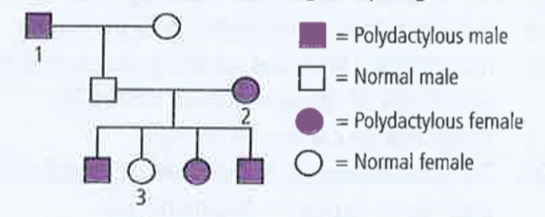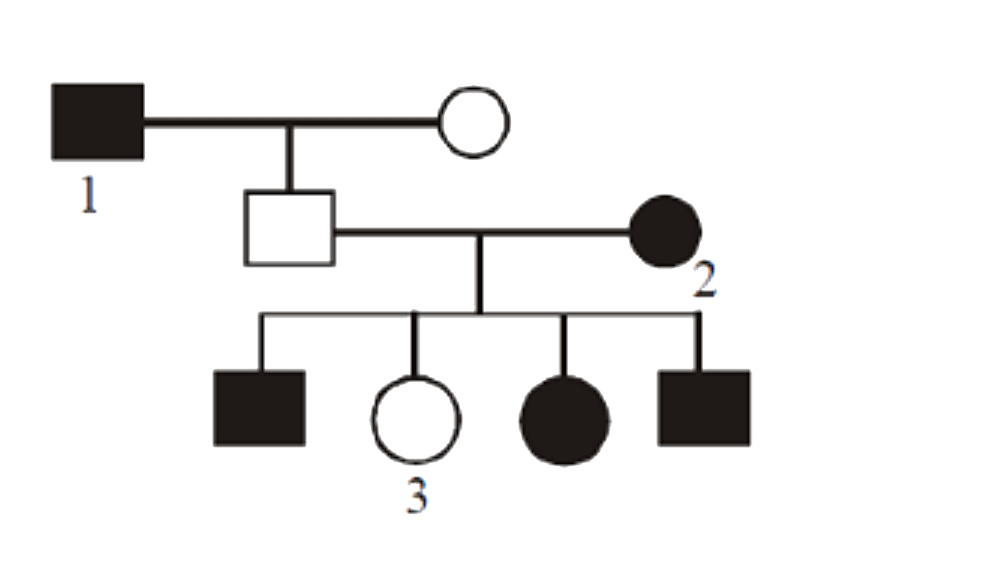In humans polydactyly (i.e., presence of extra fingers and toes) is determined by a dominant autosomal allele (P) and the normal condition is determined by a recessive allele (p). Find out the possible genotypes of family members 1,2 and 3 in the given pedigree

1 2 3PP Pp pp
1 2 3PP PP pp
1 2 3Pp PP Pp
1 2 3Pp Pp pp
The correct Answer is:D
Given pedigree chart for polydactyly (autosomal dominant trait) can be explained as follows :

Topper's Solved these Questions
- PRINCIPLES OF INHERITANCE & VARIATIONBOOK - NCERT FINGERTPS ENGLISHCHAPTER - PRINCIPLES OF INHERITANCE & VARIATIONEXERCISE - HOTS
5 Videos
- PRINCIPLES OF INHERITANCE & VARIATIONBOOK - NCERT FINGERTPS ENGLISHCHAPTER - PRINCIPLES OF INHERITANCE & VARIATIONEXERCISE - EXEMPLAR
17 Videos
- PRACTICE PAPERSBOOK - NCERT FINGERTPS ENGLISHCHAPTER - PRACTICE PAPERSEXERCISE - Practice paper
150 Videos
- REPRODUCTION IN ORGANISMBOOK - NCERT FINGERTPS ENGLISHCHAPTER - REPRODUCTION IN ORGANISMEXERCISE - All Questions
137 Videos
Similar Questions
Given below is a pedigree showing the inheritance of an autosomal dominant disorder.

The genotypes of person 1, 2 and 3 in this family tree are:
View SolutionGiven below is a pedigree showing the inheritance of an autosomal dominant disorder.

The genotypes of person 1, 2 and 3 in this family tree are:
View Solution
Knowledge Check
In each question below, is given a group of letters followed by four combinations of digits/ symbols numbered (1). (2), (3) and (4). You have to find out which of the combinations correctly represents the groups of letters based on the following coding system and the conditions and mark the number of that combination as your answer. If none of the combinations correctly represents the group of letters, mark (5) i.e. ''None of these' as your answer.
नीचे दिए गए प्रत्येक प्रश्न में अक्षरों का एक समूह दिया गया है जिसके बाद अंकों/प्रतीकों के चार संयोजन हैं (1), (2), (3) और (4)। आपको यह पता लगाना है कि निम्नलिखित कोडिंग प्रणाली और शर्तों के आधार पर कौन सा संयोजन अक्षरों के समूहों का सही प्रतिनिधित्व करता है और उस संयोजन की संख्या को अपने उत्तर के रूप में चिह्नित करें। यदि कोई भी संयोजन अक्षरों के समूह का सही ढंग से प्रतिनिधित्व नहीं करता है, तो अपने उत्तर के रूप में (5) अर्थात 'इनमें से कोई नहीं' चिह्नित करें।
{:("Letters",M,I,K,T,A,B,E,J,W,F,H,U,D,P,Y,),("Digit//Symbol code",6,**,5,©,7,8,"@",1,2,3,4,%,9,#,$,):}
Conditions( शर्तेँ):
(i) If the first letter is a vowel and the last letter is a consonant, the codes are to be interchanged(यदि पहला अक्षर एक स्वर है और अंतिम अक्षर एक व्यंजन है, तो कूटों को आपस में बदलना होगा)
(ii) If the first letter is a consonant and the last letter is a vowel, both are to be coded as the code for the vowel(यदि पहला अक्षर एक व्यंजन है और अंतिम अक्षर एक स्वर है, तो दोनों को स्वर के कोड के रूप में कोडित किया जाना है).
(iii) If both the first and the last letters are vowels, both are to be coded as "d'' (यदि पहले और अंतिम दोनों अक्षर स्वर हैं, तो दोनों को "d" के रूप मे कूटबद्ध किया जाएगा).
IPTWHYA(a)$#©24∗B(b)∗#©24$C(c)$#©24$D(d)∗#©24∗Find the code for given word using the help of given information.
दी गई जानकारी की सहायता से दिए गए शब्द के लिए कूट ज्ञात कीजिए
Conditions( शर्तेँ):
(i) If the first letter is a vowel and the last letter is a consonant, the codes are to be interchanged(यदि पहला अक्षर एक स्वर है और अंतिम अक्षर एक व्यंजन है, तो कूटों को आपस में बदलना होगा)
(ii) If the first letter is a consonant and the last letter is a vowel, both are to be coded as the code for the vowel(यदि पहला अक्षर एक व्यंजन है और अंतिम अक्षर एक स्वर है, तो दोनों को स्वर के कोड के रूप में कोडित किया जाना है).
(iii) If both the first and the last letters are vowels, both are to be coded as "d'' (यदि पहले और अंतिम दोनों अक्षर स्वर हैं, तो दोनों को "d" के रूप मे कूटबद्ध किया जाएगा).
HFIMEDA(a) 4∗36@9B(b) 93∗6@4C(c) 43∗6@9D(d) 93∗6@9In each question below, is given a group of letters followed by four combinations of digits/ symbols numbered (1). (2), (3) and (4). You have to find out which of the combinations correctly represents the groups of letters based on the following coding system and the conditions and mark the number of that combination as your answer. If none of the combinations correctly represents the group of letters, mark (5) i.e. ''None of these' as your answer.
नीचे दिए गए प्रत्येक प्रश्न में अक्षरों का एक समूह दिया गया है जिसके बाद अंकों/प्रतीकों के चार संयोजन हैं (1), (2), (3) और (4)। आपको यह पता लगाना है कि निम्नलिखित कोडिंग प्रणाली और शर्तों के आधार पर कौन सा संयोजन अक्षरों के समूहों का सही प्रतिनिधित्व करता है और उस संयोजन की संख्या को अपने उत्तर के रूप में चिह्नित करें। यदि कोई भी संयोजन अक्षरों के समूह का सही ढंग से प्रतिनिधित्व नहीं करता है, तो अपने उत्तर के रूप में (5) अर्थात 'इनमें से कोई नहीं' चिह्नित करें।
LettersMIKTABEJWFHUDPYDigit//Symbol code6∗5©78@1234%9#$
Conditions( शर्तेँ):
(i) If the first letter is a vowel and the last letter is a consonant, the codes are to be interchanged(यदि पहला अक्षर एक स्वर है और अंतिम अक्षर एक व्यंजन है, तो कूटों को आपस में बदलना होगा)
(ii) If the first letter is a consonant and the last letter is a vowel, both are to be coded as the code for the vowel(यदि पहला अक्षर एक व्यंजन है और अंतिम अक्षर एक स्वर है, तो दोनों को स्वर के कोड के रूप में कोडित किया जाना है).
(iii) If both the first and the last letters are vowels, both are to be coded as "d'' (यदि पहले और अंतिम दोनों अक्षर स्वर हैं, तो दोनों को "d" के रूप मे कूटबद्ध किया जाएगा).
EYBEJAA(a) @$8∘17B(b) 7$8@1dC(c) d$8@1dD(d) 7$8@1@
Find correct number of statement (s) w.r.t test cross.
(i) It s cross between dominant unknown genotype and recessive parent.
(ii) It is cross between the progeny of F1 generation and recessive parent.
(iii) To determine the genotype of a tall pea plant at F2 generation
(iv) to find out the genotype of dwarf pea plant in F22 generation
View SolutionFind correct number of statement (s) w.r.t test cross.
(i) It s cross between dominant unknown genotype and recessive parent.
(ii) It is cross between the progeny of F1 generation and recessive parent.
(iii) To determine the genotype of a tall pea plant at F2 generation
(iv) to find out the genotype of dwarf pea plant in F22 generation
View SolutionIn each question below, is given a group of letters followed by four combinations of digits/ symbols numbered (1). (2), (3) and (4). You have to find out which of the combinations correctly represents the groups of letters based on the following coding system and the conditions and mark the number of that combination as your answer. If none of the combinations correctly represents the group of letters, mark (5) i.e. ''None of these' as your answer.
नीचे दिए गए प्रत्येक प्रश्न में अक्षरों का एक समूह दिया गया है जिसके बाद अंकों/प्रतीकों के चार संयोजन हैं (1), (2), (3) और (4)। आपको यह पता लगाना है कि निम्नलिखित कोडिंग प्रणाली और शर्तों के आधार पर कौन सा संयोजन अक्षरों के समूहों का सही प्रतिनिधित्व करता है और उस संयोजन की संख्या को अपने उत्तर के रूप में चिह्नित करें। यदि कोई भी संयोजन अक्षरों के समूह का सही ढंग से प्रतिनिधित्व नहीं करता है, तो अपने उत्तर के रूप में (5) अर्थात 'इनमें से कोई नहीं' चिह्नित करें।
LettersMIKTABEJWFHUDPYDigit//Symbol code6∗5©78@1234%9#$
Conditions( शर्तेँ):
(i) If the first letter is a vowel and the last letter is a consonant, the codes are to be interchanged(यदि पहला अक्षर एक स्वर है और अंतिम अक्षर एक व्यंजन है, तो कूटों को आपस में बदलना होगा)
(ii) If the first letter is a consonant and the last letter is a vowel, both are to be coded as the code for the vowel(यदि पहला अक्षर एक व्यंजन है और अंतिम अक्षर एक स्वर है, तो दोनों को स्वर के कोड के रूप में कोडित किया जाना है).
(iii) If both the first and the last letters are vowels, both are to be coded as "d'' (यदि पहले और अंतिम दोनों अक्षर स्वर हैं, तो दोनों को "d" के रूप मे कूटबद्ध किया जाएगा).
BMJKPU
View SolutionIn each question below, is given a group of letters followed by four combinations of digits/ symbols numbered (1). (2), (3) and (4). You have to find out which of the combinations correctly represents the groups of letters based on the following coding system and the conditions and mark the number of that combination as your answer. If none of the combinations correctly represents the group of letters, mark (5) i.e. ''None of these' as your answer.
नीचे दिए गए प्रत्येक प्रश्न में अक्षरों का एक समूह दिया गया है जिसके बाद अंकों/प्रतीकों के चार संयोजन हैं (1), (2), (3) और (4)। आपको यह पता लगाना है कि निम्नलिखित कोडिंग प्रणाली और शर्तों के आधार पर कौन सा संयोजन अक्षरों के समूहों का सही प्रतिनिधित्व करता है और उस संयोजन की संख्या को अपने उत्तर के रूप में चिह्नित करें। यदि कोई भी संयोजन अक्षरों के समूह का सही ढंग से प्रतिनिधित्व नहीं करता है, तो अपने उत्तर के रूप में (5) अर्थात 'इनमें से कोई नहीं' चिह्नित करें।
LettersMIKTABEJWFHUDPYDigit//Symbol code6∗5©78@1234%9#$
Conditions( शर्तेँ):
(i) If the first letter is a vowel and the last letter is a consonant, the codes are to be interchanged(यदि पहला अक्षर एक स्वर है और अंतिम अक्षर एक व्यंजन है, तो कूटों को आपस में बदलना होगा)
(ii) If the first letter is a consonant and the last letter is a vowel, both are to be coded as the code for the vowel(यदि पहला अक्षर एक व्यंजन है और अंतिम अक्षर एक स्वर है, तो दोनों को स्वर के कोड के रूप में कोडित किया जाना है).
(iii) If both the first and the last letters are vowels, both are to be coded as "d'' (यदि पहले और अंतिम दोनों अक्षर स्वर हैं, तो दोनों को "d" के रूप मे कूटबद्ध किया जाएगा).
ABJFEP
View SolutionRead the following statements regarding Mendelian inheritance and choose the correct option
1. Mendel's experiments had samll sample size which gave greater credibility to the data
2. A true breeding line shows a stable trait inheritance and expression for several generations
3. In a dissimilar pair of factors, one member of the pair dominates over the other
4. A recessive parental trait is expressed only in its heterozygous condition
5. Two alleles of a gene are located on homologous sites on homologus chromosomes
View Solution
